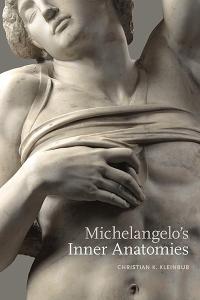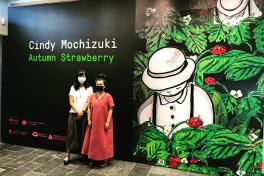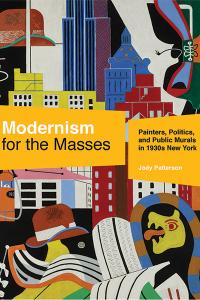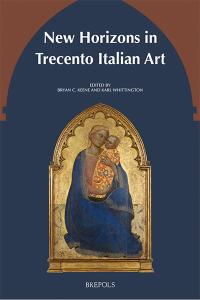Julia Andrews
Distinguished University Professor of Chinese Art
Professor Andrews presented two major lectures this past spring. The keynote “Taiwanese Abstraction in the Martial Law Period,” on May 8, 2021, kicked off the UCLA conference “Peripheral Modernism in the Global Context: Art and Society in Taiwan,” organized by Hui-shu Lee. A volume of essays edited by Dr. Lee is now in preparation. Her lecture on June 17, 2021, “Women Artists in Twentieth-Century China: A Prehistory of the Contemporary,” was the second annual BAMPFA (Berkeley Art Museum-Pacific Film Archive) Lijin Collection Lecture. Originally planned at the museum for the spring of 2020, it became a virtual event now archived online.
Andrews is currently writing an essay on the impact of the French artist Andre Claudot’s teaching career in Beijing and Hangzhou on the subsequent development of modern Chinese art for a Getty-sponsored anthology tentatively titled Entangled Modernisms: Chinese Artists Trained in Europe. Andrews also completed revisions to The Colors of China, a chapter on Japanese oil painters and the continent for an anthology edited by Tamaki Maeda and Joshua Fogel on Chinese impact on modern Japanese art.
This summer, Andrews drafted the introduction for a co-edited volume that grew out of the conference “Global Art Exchange and Modernism,” which was co-organized by Shuyu Kong and Zheng Shengtian at Simon Fraser University, Oct. 30-31, 2020. The diverse papers document surprising accounts of survival and productive cross-cultural encounter in the otherwise constrained Cold War era. She also participated in several virtual conferences. Joining three department alumnae, she served as discussant for the panel “Linking Asia to the World: Asian Urban Culture and Visual Art in the 1930s” at the virtual Association of Asian Studies annual meeting on March 23, 2021. The 12th International Convention of Asia Scholars, which was virtual, was hosted by Kyoto Seika University. On Aug. 26, 2021, Andrews served as discussant for “Translating Art and Heritage in the Press: A Global Perspective,” an international panel of scholars that included two department alumni.
Andrews’ initiative with Miki Morita of the British Library’s International Dunhuang Project and Wexner Center for the Arts colleagues Mary VanWassenhove and Kim Kollman to make high-resolution photographs of the Wiant collection’s Tang Dynasty Diamond Sutra available for scholarly study came to fruition.
After teaching remotely for two-and-a-half semesters, Andrews was delighted to see graduate students and colleagues in person in the late spring and summer, and especially the new students who she knew only from seminars on Zoom. The summer of 2021 saw several of her graduate students complete their theses. Yiwen Liu’s dissertation “Becoming an Art Space: The Daxin Gallery and the Art World in Republican Shanghai (1912-1949)” focused on the significance of new exhibition venues for art in the first half of the twentieth century. Linda Huang’s manuscript, “Re-imagining Post-socialist Corporeality: Technology, Body, and Labor in Post-Mao Chinese Art,” presented a framework for original interpretations of key artistic trends of the 1980s. Asia Adomanis, in her MA thesis co-advised by Roy Lichenstein Foundation Chair of Art History Jody Patterson, “‘In-between’ Primitivism: Miguel Covarrubias’ Circle from Harlem to Shanghai,” found connections in commercial art and design that spanned continents among those who came in contact with the Mexican modernist.
Andrews is currently a member-at-large of the National Committee for the History of Art. During the 2021-2022 academic year she will be on faculty professional leave to complete her book manuscript on various forms of modern art explored by artists of China’s Republican Period (1911-1949).
Lisa Florman
Professor of Modern Art, Arts and Sciences Associate Dean of Interdisciplinary Studies and Community Engagement
Lisa Florman stepped down from her position as chair of the Department of History of Art at the end of June to accept a position as associate dean for Interdisciplinary Studies and Community Engagement in the College of Arts and Sciences. Among her many duties, she will oversee programming and other initiatives related to the Arts District and the arts at Ohio State more generally. Her essay "Behind Picasso’s Pins" appeared at the end of last year as a chapter in the book 1913, The Year of French Modernism (Manchester University Press), edited by Effie Rentzou and André Benhaïm. Another essay, "Twentieth-Century Art Historicities: The Multiple Shapes of Time," will appear next fall in Stefanos Geroulanos, ed., A Cultural History of Ideas in the Modern Age (Bloomsbury).
Mark Fullerton
Professor of Ancient Art
During the summer of 2019, Professor Mark Fullerton travelled to Greece, Cyprus and Turkey to conduct research for his current project regarding early archaic Greek sculpture. While in Athens, he delivered a paper, Archaism and Autochthony on the Post-Periklean Acropolis, at the American School of Classical Studies to be published October 2021 in Neils, J. and Palagia, O., eds. Kallias to Kritias: Classical Culture: Athens in the Second Half of the 5th Century B.C. (De Gruyter) pp.31-49. His most recent book, Roman and Archaeology, was published by Thames & Hudson in the United Kingdom and U.S. in 2020 and in China (in translation) in 2021. He also published three book reviews: of William A.P. Childs, Greek Art and Aesthetics in the 4th Century B.C. Department of Art and Archaeology. Princeton University. In association with Princeton University Press. Princeton and Oxford, 2018. Bryn Mawr Classical Review 2021 (online); Carol L. Lawton, Votive Reliefs. The Athenian Agora. Results of Excavations Conducted by the American School of Classical Studies at Athens. Volume 38. The American School of Classical Studies at Athens. Princeton, NJ: 2017. 248 pp, 12 col figs, 3 col and b/w plans, 60 pls. Journal of Greek Archaeology. 2020 (online); and Angelicoussis, Elizabeth, Andrew Stewart, Daniella Ben-Arie and Gerard M. F. Hill (ed.), Reconstructing The Lansdowne Collection Of Classical Marbles, (2 vols.). Munich: Hirmer, 2017. 624 pp. Bryn Mawr Classical Review 2019 (online). He has developed and is now offering a new fully online general education course: “History of Art 2301: Classical Archaeology,” which was offered for the first time in summer of 2021.
Byron Hamann
Associate Professor of Latin American Art
Byron Hamann was a senior research fellow at the Center for Advanced Study of the Visual Arts (CASVA) at the National Gallery of Art in Washington, D.C., during the 2020-2021 academic year and is currently a fellow at the Institute for Advanced Study’s School of Historical Study in Princeton. At CASVA, he presented a public colloquium, “A History of Mexico through Histories of ‘The Conquest’: The Lienzo de Tlaxcala Remade, 1552-2012.” His book, Bad Christians, New Spains: Muslims, Catholics, and Native Americans in a Mediterratlantic World, was published by Routledge in 2020.

Christian Kleinbub
Professor of Italian Renaissance Art
Having published a second book, Michelangelo’s Inner Anatomies (Penn State University Press, 2020), Chrisitan Kleinbub returned to the subject of his first book to contribute to the celebrations surrounding the quincentenary of Raphael’s death in 1520. The result has been three articles appearing in Source: Notes in the History of Art, Raphael: Drawing and Eloquence, and the forthcoming volume, Raphael’s Stanze Revisited. More recently, he has turned his attention to Leonardo da Vinci and is identifying links between the artist’s scientific endeavors and medieval and early modern mysticism. Beyond his online teaching, Kleinbub has contributed to The Brooklyn Rail, including reviews of museum and gallery exhibitions (early modern and contemporary), and edited a special issue (July-August 2021) devoted to visual art and mysticism. Besides his inaugural lecture as full professor on the subject of conversation in Italian Renaissance art in February 2020, he gave a virtual lecture earlier this year on the subject of early modern naturalism sponsored by the San Diego Museum of Art.
Namiko Kunimoto
Associate Professor of Japanese Art

Namiko Kunimoto completed her sabbatical in Vancouver, British Columbia, where she worked on her next book project, Transpacific Erasures: Contemporary Art, Gender, and Race in the Afterlives of Japanese Imperialism. She published Photography and the Minamata Disaster in Global Photography, Photographic Pluralities in Blackflash Magazine, and Tsujimura Kazuko and the Body/Object in the Asia-Pacific Journal: Japan Focus. Her essay, Katsura Yuki and the Allegorical Turn, will be published in Water Moon Reflections: Essays in Honor of Patricia Berger this year. She (virtually) presented, “Transformations in Postwar Sculpture” at the Brandhorst Museum of Art, “After the Pandemic: the Future of University-Community Engagement” at Simon Fraser University, “Decolonizing Work in Art History” at the Vancouver Art Gallery, “Globalizing the 1950s: Inter-mediality and Inter-disciplinarity” at UC Santa Barbara, “Transpacific Erasures,” at Carnegie Mellon, and “The Question of Japanese Abstraction,” at Columbia University. She also virtually participated in several conferences, including “The Global Turn and Tokenism” at the International Conference of Asian Scholars, “Conversion and Continuity in Transwar Japan” at the College Art Association in 2020, and chaired the panel, “Activism in Word and Deed,” at the Seventh Feminist Art History Conference at American University. Kunimoto was thrilled that her first PhD student, Eunice Uhm, completed her dissertation, “The Subversive Possibilities of Diaspora: Aesthetic Subjectivities of Migration and Displacement in South Korean and Japanese Art, 1960s – Present,” and secured a three-year postdoc at the Kalamazoo Institute of Arts. Kunimoto received the Greater Arts and Humanities Discovery Theme Grant and the Ronald and Deborah Ratner Distinguished Teaching Award in 2020 and the Asian American Studies Service Award and an Ishibashi Japan Foundation Fellowship in 2021. She is continuing her work as the director of ethnic studies at Ohio State.
Erica Levin
Assistant Professor of Contemporary Art and Experimental Cinema
This year, Erica Levin completed her first book, The Channeled Image: Art and Media Politics After Television, which will be published by the University of Chicago Press in autumn of 2022. She also contributed to a dossier on the late artist, Carolee Schneemann, (the subject of the book’s second chapter) published by the journal Camera Obscura. In March, she co-chaired a panel at the Society of Cinema and Media Arts, “Experiments in an Open Terrain: Exhibiting Film and Video After Expanded Cinema” where she presented her paper, The Avant-Garde Newsreel. As co-chair of the association’s scholarly interest group, CinemArts, she also organized a series of professional development workshops featuring leading scholars in the field on topics such as “How to Write a Job Letter” and “How to Apply for a Postdoc.” Next spring, she looks forward to taking a group of students to New York for a field school experience sponsored by the Global Arts and Humanities Discovery Theme, where they will visit film archives, museums and galleries exhibiting experimental film.
Daniel Marcus
Assistant Professor of Practice of Art History
In July 2020, Daniel Marcus completed a two-year position as the inaugural Roy Lichtenstein Curatorial Fellow at the Columbus Museum of Art, which he had held since 2018. As the Lichtenstein Fellow, he co-curated with Jonathan Weinberg, Tyler Cann and Drew Sawyer the acclaimed exhibition “Art after Stonewall, 1969-1989,” which premiered June 2019 at the Grey Art Gallery, New York University and Leslie Lohman Museum before traveling to the Patricia and Phillip Frost Art Museum at Florida International University and finally the Columbus Museum of Art in March 2020. He also curated several exhibitions drawn from the museum’s permanent collection, including “Oppositions: Art and Power in the Vietnam War Era” and “Between Bust and Boom: Artists in the Slack Years, 1990-2005.” Alongside these projects, he organized standalone video exhibitions by the Ephraim Asili, the Otolith Group and Tourmaline and Sasha Worzel; commissioned an audio installation by the Nocturne Collective (Emma Levesque-Schaefer, Bobby T. Luck, Twinkle Panda and Prince Shakur); and a cross-departmental team developed projects and programs for CMA’s Center for Art and Social Engagement, including artist Sa’dia Rehman’s installation “The Land of Promise” (2020-21). In spring 2021, he returned to CMA to co-curate the exhibition “A Primer on the Commons” with students in his graduate course, “Commoning the Museum,” featuring commissioned projects by Binta Ayofemi, Michael Mercil and Suzanne Silver alongside works from the permanent collection.
Since August 2020, Marcus has held joint positions in the Department of History of Art and the Wexner Center for the Arts, where he is associate curator of exhibitions. In his new role at the Wex, he has co-curated with Kristin Helmick-Brunet and Megan Cavanaugh the presentation of “Taryn Simon: Assembled Audience” and worked with guest curator Mark Godfrey to realize “Jacqueline Humphries: jHΩ1:),” the first large-scale museum exhibition of Humphries’s boundary-defying abstract paintings. He wrote an essay, Screen Resistance: Jacqueline Humphries after the Internet, to accompany her show at the Wex and conducted an interview with Humphries for the Wex’s magazine, In Practice. He is currently working on a major exhibition, “To Begin, Again: A Prehistory of the Wex, 1968-89,” the first in the institution’s history to investigate the cultural ferment at Ohio State in the two decades before the center’s opening in 1989 (forthcoming in winter/spring 2022).
Alongside these projects, Marcus has written essays and reviews exploring the intersection of contemporary artistic practice, radical politics and social movements. Informed by his research for Art after Stonewall, he published an essay in Artforum tracking Keith Haring’s engagement with safer-sex activism in the 1980s; his essay on transgender aesthetics and politics in the art of painter Leidy Churchman also appeared in Artforum, as did his review of Danielle Aubert’s book The Detroit Printing Co-Op: The Politics of the Joy of Printing (Inventory Press, 2019).

Jody Patterson
Associate Professor and Roy Lichtenstein Foundation Chair of Art History
Jody Patterson joined the Department in August 2019 as the first Roy Lichtenstein Foundation Chair. Since her arrival, she has designed and delivered undergraduate classes and graduate seminars that explore the histories of American art through first-hand study of artworks in local and regional collections, including the Columbus Museum of Art, the Cleveland Museum of Art and Detroit Institute of Art. Following the publication of her book Modernism for the Masses: Painters, Politics, and Public Murals in 1930s, Jody continues her research on the relations between art, politics and the democratization of culture. She recently collaborated with the Eskenazi Museum of Art, University of Indiana, Bloomington, on the exhibition catalogue Swing Landscape: Stuart Davis and the Modernist Mural, which was selected as Outstanding Exhibition Catalogue of 2020 by the Midwest Art History Society. Her interest in public art finds resonances on campus and across the city; she contributed to the Ohio State webinar Monumental Changes, which explored the civic role of confederate monuments, and she is involved, alongside the Wexner Center for the Arts, with Art Unites Columbus initiatives to engage the Black Lives Matter murals created throughout the city.
Kris Paulsen
Associate Professor of Contemporary Art and New Media
Kris Paulsen is a Global Arts and Humanities Discovery Theme Faculty Fellow at Ohio State for the 2021-2022 academic year. During this time, she will work to complete her new book manuscript on AI and art, tentatively titled Flesh in the Machine. In 2020-2021, she published several articles and book chapters, including Shitty Automation: Art, Artificial Intelligence, and Humans in the Loop on Trevor Paglen’s use of generative adversarial networks (GANs) to create “hallucinated photographs.” A new essay on Zach Blas’s machine learning-based artworks, “It Is Decidedly So: Icosahedron’s Oracular Intelligence,” appears in a catalog on Blas’s work from Sternberg Press, and Blank Forms is reprinting “In the Beginning, There Was the Electron,” an essay on early synthesizer-based video art. Kris was the sole author of a catalog on the digital paintings of Isca Greenfield-Sanders, published by Miles McEnery Gallery in New York. She also published essays on the work of Gretchen Bender for the Wexner Center for the Arts and an essay on critical art practices engaging with biometric tracking and surveillance for OPEN! Platform for Art Culture and the Public Domain. She is currently editing a special issue of Media-N on “The Afterlives of Data.” Kris presented the Society, Culture and Thought lecture at Bennington College, interviewed renowned new media artist Lynn Hershman-Leeson in a public conversation for the Wexner Center for the Arts, and was the subject of two feature-length radio interviews on telepresent life in the pandemic. With Daniel Marcus, she oversees a large-scale and ongoing collaboration with the Columbus Museum of Art that enables students to work with curators to produce exhibitions at the museum. The first two of these collaborations opened in 2021, with two more planned for 2022-2023. Paulsen is chair of Undergraduate Studies and serves as the faculty advisor to Global Arts and Humanities Graduate Fellows, the department’s graduate curatorial club, and the History of Art Undergraduate Society. She is the co-chair of the Art & Data Research Group at the Translational Data Analytics Institute.
Andrew Shelton
Professor of Eighteenth and Nineteenth Century European Art
Andrew Shelton served as the interim chair of Ohio State’s Department of Theatre, Film, and Media Arts during the 2020-21 academic year. He published an essay entitled, Ingres, Painter of Men, in the February 2021 issue of Art History and participated in a virtual conference on 19th-century French drawings at the Cleveland Museum of Art in March 2021.
Karl Whittington
Associate Professor of Medieval Art and Interim Chair of History of Art

Over the past year, Karl Whittington completed research and a draft of his current book project, Trecento Pictoriality: Diagrammatic Painting in Late Medieval Italy, currently under review, which explores the ways in which scientific, theological, philosophical and political diagrams made their way from the pages of manuscripts to monumental artworks in public spaces in 14th-century Italy. After some COVID restrictions were lifted, Karl was able to make a research trip to Italy in June 2021 (supported by a grant from the International Center for Medieval Art), to conduct final research and take photographs for the book. The trip took him to some amazing sites in Sarzana, Lucca, Bologna, Florence, Pisa, Rome and Anagni. This year, Karl also published a volume of essays with Brepols, co-edited with Dr. Bryan Keene of Riverside City College, called New Horizons in Trecento Italian Art, with contributions from 19 scholars who presented papers at the Andrew Ladis Memorial Conference in Houston in 2018. Karl also presented papers in 2021 at online conferences for the Medieval Congress at Kalamazoo and the Renaissance Society of America, as well as gave an invited lecture at the University of Memphis and participated in an online roundtable sponsored by the ICMA on the future of queer studies in medieval art history. Karl was delighted that his PhD student, Laura Leeker, filed her dissertation and received her doctorate in 2020, with a dissertation on “Narrative and Experimentation in Fourteenth-Century Italian Chapter Houses.” In the classroom, Karl taught a new graduate seminar in spring 2021 on “The Crucifix and Crucifixion in a Global Art History,” looking with five PhD students in the Department of History of Art at the origins of crucifixion imagery in the Mediterranean world and its expansion and transformation around the world through the modern period.
